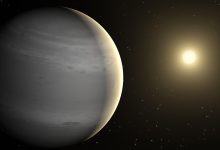K2-89 b: A Terrestrial Exoplanet in the Depths of the Universe
The search for exoplanets—worlds orbiting stars beyond our solar system—has provided incredible insights into the diversity and nature of planetary systems in the universe. Among the numerous discoveries facilitated by modern astronomical techniques is K2-89 b, a terrestrial exoplanet located approximately 281 light-years away from Earth. This article delves deeply into the characteristics, discovery, and significance of K2-89 b, shedding light on its importance in the context of planetary science and exoplanetary research.
Discovery and Detection
K2-89 b was discovered in 2016 as part of the Kepler mission’s extended effort to identify exoplanets using the transit method. This method involves detecting minute dips in a star’s brightness as a planet passes, or transits, in front of its host star. The precise detection of K2-89 b is attributed to Kepler’s ability to observe small changes in stellar luminosity, marking another milestone in the catalog of exoplanetary discoveries.
The star K2-89, around which this planet orbits, has a stellar magnitude of 14.162, rendering it relatively faint when viewed from Earth. Despite its dimness, advances in instrumentation allowed astronomers to identify the planet’s characteristics and refine its orbital parameters.
Physical Characteristics of K2-89 b
K2-89 b is classified as a terrestrial planet, meaning it shares physical characteristics with rocky worlds like Earth, Mars, and Venus. However, this classification does not necessarily imply habitability, as its specific attributes and environment present unique challenges.
Mass and Radius
With a mass multiplier of 0.17 times that of Earth, K2-89 b is significantly lighter than our home planet. In terms of size, its radius is about 0.615 times that of Earth. The relatively small size and low mass suggest that K2-89 b is a rocky planet with a thin or absent atmosphere, as larger planets often retain dense, gaseous envelopes.
Orbital and Rotational Dynamics
K2-89 b’s proximity to its host star is striking, with an orbital radius of just 0.01462 AU (astronomical units), approximately 1.46% of the Earth-Sun distance. This places it extremely close to its parent star, resulting in a remarkably short orbital period of just 0.003011636 years—or roughly 1.1 days.
Such tight orbits often lead to tidal locking, where one side of the planet perpetually faces the star while the other remains in darkness. The eccentricity of K2-89 b’s orbit, measured at 0.15, further complicates its environmental dynamics, possibly contributing to temperature variations across its surface.
The Stellar Host: K2-89
K2-89 is a relatively dim star, with a magnitude of 14.162. While not particularly luminous, it is energetic enough to exert significant gravitational and thermal influences on K2-89 b. The star’s characteristics make it a fascinating subject for studies into star-planet interactions, particularly for planets in such close orbits.
Detection via Transit Method
The transit method, responsible for the discovery of K2-89 b, has been pivotal in identifying thousands of exoplanets. By continuously monitoring the brightness of K2-89, astronomers detected the periodic dimming events caused by the planet’s transit.
This method provides not only the orbital period of the planet but also its radius relative to the host star. By combining these measurements with follow-up radial velocity studies or stellar modeling, scientists can estimate the planet’s mass and density. For K2-89 b, these data confirmed its status as a terrestrial planet and provided insights into its composition.
Potential for Habitability
Given its extreme proximity to its host star, K2-89 b resides well within what is often referred to as the “hot zone,” far from the traditional habitable zone where liquid water might exist. The intense radiation from its star likely prevents the formation or retention of an atmosphere conducive to life as we know it.
The surface temperatures on K2-89 b are expected to be extremely high, potentially resulting in molten rock and other volatile processes on its surface. While this precludes habitability, the study of such planets is crucial for understanding the diversity of planetary environments in the galaxy.
Broader Implications for Exoplanet Research
The discovery of K2-89 b underscores the effectiveness of the transit method and the capabilities of space telescopes like Kepler in detecting small, terrestrial exoplanets. It also highlights the diversity of planetary systems, demonstrating that planets can form and survive in extreme environments.
Challenges of Close-Orbit Planets
Planets like K2-89 b provide valuable data for modeling star-planet interactions. The proximity to their host stars subjects such planets to intense gravitational forces, which can lead to tidal heating, atmospheric stripping, and even orbital decay over time. Understanding these processes can help refine theories of planetary evolution and survival.
Future Studies
Follow-up studies using advanced telescopes, such as the James Webb Space Telescope (JWST), could provide further insights into K2-89 b’s atmospheric composition (if any exists) and surface conditions. Additionally, the planet’s unique orbital characteristics offer a natural laboratory for studying tidal effects and thermal redistribution.
Conclusion
K2-89 b is a fascinating example of a terrestrial exoplanet in a harsh and extreme environment. While it may not support life or resemble Earth in any direct way, its discovery adds to the growing body of knowledge about planetary diversity in the universe.
By studying such planets, astronomers can refine their understanding of how planetary systems form, evolve, and interact with their stellar hosts. K2-89 b serves as a reminder of the vast and varied nature of the cosmos, where each discovery deepens our appreciation for the complexity of the universe and our place within it.
| Property | Value |
|---|---|
| Distance from Earth | 281 light-years |
| Stellar Magnitude | 14.162 |
| Planet Type | Terrestrial |
| Discovery Year | 2016 |
| Mass (Relative to Earth) | 0.17 |
| Radius (Relative to Earth) | 0.615 |
| Orbital Radius | 0.01462 AU |
| Orbital Period | 1.1 days |
| Eccentricity | 0.15 |
| Detection Method | Transit |

